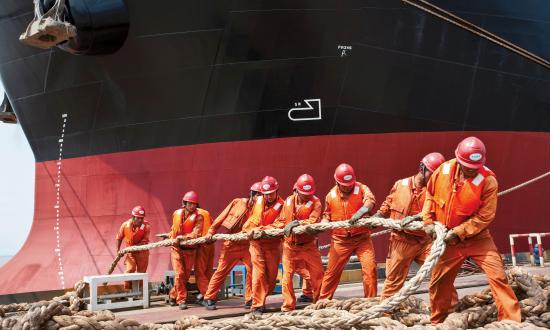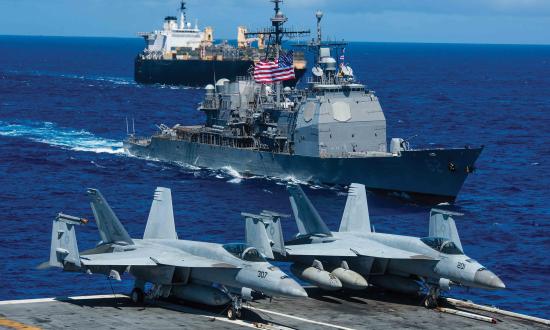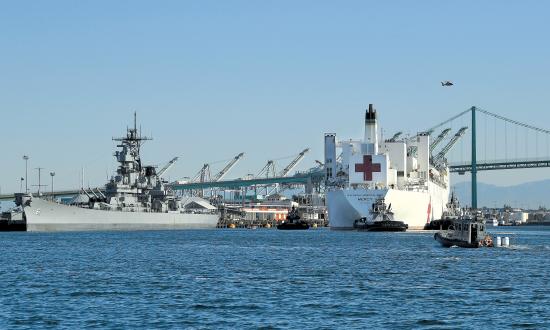The COVID-19 pandemic will have long-term ramifications on the nation, from the deaths of more than 300,000 Americans to a massive spike in federal spending—at least an additional $4 trillion. As a result, the world will look much different after this event and the U.S. Navy will face changes in how it operates in the future. The potential for smaller budgets and a shift in priorities will impact operations. One of the actions the Navy may be forced to consider will be a decreased forward presence and reduced deployments to lower costs.
With Gerald R. Ford-class nuclear carriers and Columbia nuclear ballistic missile submarines in the Future Year Defense Program, a large percentage of the Navy’s funds are allocated to the construction of these high-ticket items. At the same time, the new Constellation-class frigate, sealift recapitalization, and the continued production of Arleigh Burke–class destroyers and Virginia-class attack submarines place severe constraints on the Navy to achieve the elusive 355-ship goal. If the U.S. Navy was forced to reduce its forward presence, as the Royal Navy did more than a century ago, it would need to look far back in its own history to relearn the lessons of having to surge forces under a more expeditionary model when needed.
World War I
When the U.S. Congress declared war on Germany on 6 April 1917—four days after President Woodrow Wilson spelled out the trepidations of Imperial German U-boats sinking 10 U.S. merchant ships and killing 64 crewmen—the bulk of the U.S. Navy was concentrated off Yorktown, Virginia.1 The U.S. presence overseas was limited to a few ships in the eastern Mediterranean and an Asiatic Fleet in the Philippines that was little more than a squadron of old cruisers, torpedo boats, and gunboats. On the U.S. West coast, there was a force of armored cruisers and older destroyers, but all the nation’s capital ships of that age—the all big-gun dreadnoughts—were concentrated on the East coast.
On 1 April 1917, the fleet included 282 ships. By 1 November 1918, the Navy grew to 1,498 with 373 ships stationed in Europe under Vice Admiral William S. Sims.2 By comparison, on 14 December 2020, the fleet consisted of 296 ships with 98 deployed overseas. Today, the Navy relies on a much higher percentage of forward-deployed units, task groups that deploy and then rotate back to bases in the United States, and a diminished number of forward bases. In 1917, the Navy had to rapidly deploy hundreds of ships to Europe, a feat that required a massive logistics and supply effort—something the United States is currently incapable of replicating, at least on short notice.
To overcome the shortages in supply, the World War I Navy turned to the commercial merchant marine. In September 1917, the Navy leased six tankers from the U.S. merchant marine. These ships were brought into the Navy and their crews—those who were U.S. citizens—were offered positions in the Naval Auxiliary Reserve Force.3 The militarization of these vessels allowed the Navy to not merely keep their ships supplied, but also move oil necessary for the Royal Navy.
The addition of thirteen German interned freighters was instrumental to success during the war. Ten of the thirteen freighters became cargo ships, while the other three were modified into destroyer tenders. The ships were used to haul stores and munitions, and the USS Newport News (AK-3) transported the Navy crewed 14-inch gun railway batteries to France.4
Yet by March 1918, there was still an insufficient number of ships to sustain U.S. forces in Europe, and the shipyards were at capacity with delivery still slow. The U. S. government decided to invoke the medieval Right of Angary. Using the justification of war, federal marshals seized 87 neutral Dutch ships in American ports. The ships entered U.S. service as transports and freighters, while their crews were interned and returned to the Netherlands.5
As the British and Americans organized against the German submarines, the tactic they agreed on was the convoying of ships. In ports in the United States, Canada, Gibraltar, and western Africa, convoys were formed and sailed toward western Europe. They were met by destroyer divisions and escorted through the Western Approaches. To shepherd them from their ports of embarkation, cruisers were assigned to oversee the convoys, and naval armed guard detachments placed on board merchant ships to prevent and deter attacks by German surface ships including the larger U-cruisers.
The result of American efforts in the First World War was not the defeat of the German U-boats, but their eventual suppression. By lowering the number of ships being sunk, by increasing the tonnage of goods being shipped, and, in coordination with allies, transporting 1.5 million troops between March and September 1918, they were able to swing the balance on the Western Front.6
Could the Navy Be that Expeditionary Today?
While it may be hard to envision a reduction in U.S. naval presence on the world’s seas, the situation today may necessitate such action. A conflict erupting in Southeast Asia is not beyond imagination. If global trade is disrupted, the United States may find itself involved in a regional conflict while relying on a Navy that is more of a continental-based force and must project its power from U.S. shores. The Chairman of the Joint Chiefs of Staff, General Mark A. Milley, emphasized this point at the 3 December 2020 U.S. Naval Institute’s Defense Forum Washington, “The fundamental defense of the United States, and the ability to project power forward is going to be naval and air and space power.”
During World War I, the U. S. Navy relied on four factors to make it a viable expeditionary-projection force: shipyards; tenders; replenishment; and protection of convoys. The use of Navy Yards was essential to prepare the destroyers for Europe in those early months. Commercial yards were booked with new construction and repair work and could not prioritize Navy ships. Today, the nation lacks even this capability. With reductions in commercial yards, and only four Navy shipyards remaining, the Government Accountability Office concluded, “In 2017, we reported that the shipyards had not been fully meeting the Navy’s operation needs.” A recent Center for Strategic and Budgetary Assessments study stated, “Commercial ship repair yards are newer and potentially more efficient than U.S. public shipyards but are also experiencing worker shortfalls.” Even with Navy investment in their own shipyards under the 2019 Shipyard Infrastructure Optimization Plan, the decline in the maritime industry infrastructure because of the decrease in the number of ships built and maintained annually in both the Navy and commercial merchant marine has substantially impacted repair and maintenance facilities.
In the fleet today, only two submarine tenders remain, and the last destroyer tenders left the fleet nearly 25 years ago. This means that mobile repair facilities for the Navy are nearly non-existent. In World War II, portable floating dry docks and tenders achieved the same result in the far reaches of the Pacific. When the USS McCain (DDG-56) and Fitzgerald (DDG-62) suffered their collisions in 2017, they both had to be loaded on chartered foreign-flagged heavy lift ships and taken to repair facilities; McCain to Yokosuka and Fitzgerald to Pascagoula. Both required more than two and a half years to return to service, as opposed to the nine months it took to repair the USS Cassin (DD-43) in a British shipyard in 1917–1918 after being severely damaged by a German torpedo.
In the area of fleet supply, while the Navy’s Military Sealift Command possesses a force of 29 modern and capable oilers and supply ships, it resupplies them from forward depots. In case of a withdrawal to the continental United States or a deployment to a region without such facilities, the Navy would need shuttle ships to keep them supplied. These ships would either need to be drawn from a dwindling American merchant fleet—only 183 deep-draft ships remain—or foreign ships bought or seized.
The Jones Act, which celebrated its centennial on 5 June 2020, ensures there is a U.S.-flagged, -built, -crewed, and -owned fleet of ships available in a time of peer-to-peer conflict.7 In World War I, six tankers were drawn from the coastal trade. In World War II, the Navy took over 12 T-3 Cimarron tankers built for Esso and Keystone, and they provided the support for the fast carriers during the early 1942 raids and at the battles of Coral Sea and Midway and invasions of Guadalcanal and North Africa. But strong lobbying by groups like the American Enterprise Institute and the Cato Institute aims to repeal the law and open the protected cabotage trade to foreign-flagged vessels, eliminating even these American-flagged ships and their mariners.
The use of the Right of Angary in March 1918 could be exercised again in a large conflict. At any moment, hundreds of foreign-flagged ships are in American ports. Many are flagged under open registries, including some from China and Hong Kong. The issue would not be the acquisition of tonnage, but the ability to repair the ships if sabotaged and finding the requisite crews. In March 2019, the commander of the U.S. Transportation Command and the head of the Maritime Administration identified a shortfall of 1,800 mariners. A subsequent test, in September 2019, of the surge sealift force indicated that only 40 percent of the 61 ships in the reserve fleet successfully met their activation requirements.
Since 1945, the United States has been engaged in many conflicts, but in none of them has its overseas shipments been threatened. In October 2018, the Navy remarked to the head of the Maritime Administration concerning ocean escorts of convoys, “You’re on your own: go fast, stay quiet.” In February 2020, the USS Vella Gulf (CG-72), a Ticonderoga-class cruiser, escorted two cargo ships participating in Exercise Defender 2020. The use of a cruiser for this mission harkened back to ocean escorts of World War I. The Vella Gulf picked up the ships off Texas and escorted them to Europe; a trip of more than 6,000 nautical miles. Arleigh Burke–class destroyers or littoral combat ships could not achieve this without underway replenishment, hence the selection of a cruiser. Another issue was the need for area defense by Vella Gulf’s missiles and the lack of onboard defense on the two merchant ships, like a World War I–era armed-guard detachment. Instead of repurposed secondary armament, containerized Standard missiles on deck along with modularized SeaRAM Rolling Airframe Missile or Phalanx Close-In Weapon System (CIWS), slaved to Vella Gulf’s fire-control system, could provide expanded coverage for the ships from antiair defense and provide distributed cooperative defense. However, neither ship was fitted for the exercise.
Should the Navy have to reduce its presence, lose access to some of its few remaining forward bases, and then deploy into an area that it does not expect, it currently lacks the means to do so. The maritime infrastructure of the nation needs significant investment so it could quickly prepare its vessels. The Navy needs to invest in tenders or modular repair facilities to maintain ships in a forward operating area. It would also need vessels and crews to replenish them, meaning a viable American merchant marine with ships, trained personnel, and shipyards. Finally, it must ensure the safe arrival of supplies by defending merchant shipping with convoy escorts.
1. Rodney Carlisle, Sovereignty at Sea: U.S. Merchant Ships and American Entry into World War I (Gainesville: University of Florida Press, 2009).
2. United States Senate, Naval Investigation Hearing before the Subcommittee of the Committee on Naval Affairs, (2d Session 66th Congress, 1921), 1235.
3. Lewis P. Clephane, History of the Naval Overseas Transportation Service in World War I (Washington: Naval History Division, 1969), xviii.
4. William Lowell Putnam, The Kaiser’s Merchant Ships in World War I (Jefferson, North Carolina: McFarland & Company, Inc.).
5. Edward N. Hurley, The Bridge to France (Philadelphia: J. B. Lippincott, 1927), Chapter XIII.
6. Thomas G. Frothingham, The American Reinforcement in the World War (Garden City: Doubleday, Page & Company, 1927).
7. See Salvatore R. Mercogliano, “A Century of the Jones Act,” Sea History 169 (Winter 2019), 12–16.







